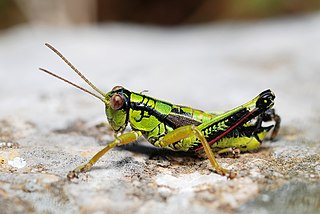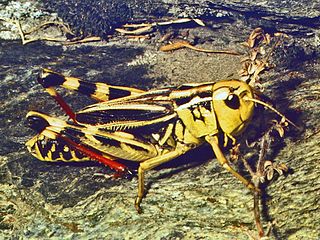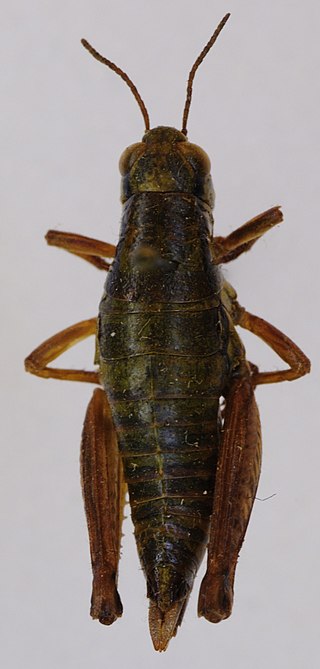
The Melanoplinae are a subfamily of grasshoppers in the family Acrididae. They are distributed across the Holarctic and Neotropical realms. They are one of the two largest subfamilies in the Acrididae. As of 2001 the Melanoplinae contained over 800 species in over 100 genera, with more species being described continuously.

Chorthippus is a large genus of acridid grasshoppers with around 230 described species. The genus may be subdivided into subgenera including: Altichorthippus, Chorthippus and Glyptobothrus, with other species not placed.

Miramella is a small genus of short-horned grasshoppers in the subfamily Melanoplinae. They are found in Europe and eastern Asia. As of January 2019, Orthoptera Species File lists seven species in three subgenera. The genus was first named in 1932. Miramella is the type genus of the subtribe Miramellina.

Stenobothrus is a genus of grasshoppers found in Asia, Europe, and North Africa.

Arcyptera is a genus of grasshoppers belonging to the family Acrididae subfamily Gomphocerinae. These grasshoppers are present in mainland Europe, and in the eastern Palearctic realm through to northeastern Asia.

Pseudoprumna is a monotypic genus of grasshoppers in the subfamily Melanoplinae and tribe Podismini. The only species is Pseudoprumna baldensis.

Chrysochraontini is a tribe of grasshoppers belonging to the subfamily Gomphocerinae.

Caryanda is a large genus of grasshoppers in the subfamily Caryandinae. Species are recorded from Africa and Asia.

Myrmeleotettix is a genus of grasshopper in the tribe Gomphocerini. Species are recorded from western Europe and throughout temperate Asia.

Podismini is a tribe of "spur-throated grasshoppers" in the family Acrididae. This tribe is unlike others in the subfamily Melanoplinae in that genera are found throughout the northern hemisphere, with a substantial number occurring outside the Americas.

Megaulacobothrus is a genus of grasshoppers in the tribe Stenobothrini. Species have been recorded from northern and Temperate Asia.

The Caryandinae are a small subfamily of grasshoppers found mostly in China, India, Indochina and Malesia, but the large type genus Caryanda also has species from Africa. Genera were previously placed in the tribe Oxyini, with the subfamily erected by Yin & Liu in 1987.

Anapodisma is a genus of spur-throated grasshoppers in the family Acrididae. There are at least four described species in Anapodisma, found in eastern Asia.
Conophyma is the type genus of grasshoppers of the subfamily Conophyminae and tribe Conophymini. Species are recorded from central Asia.
Podismopsis is a genus of grasshoppers in the subfamily Gomphocerinae and tribe Chrysochraontini, erected by Zubovski in 1900. Species have been recorded from central Europe through to temperate east Asia, including Japan.

Micropodisma is a genus of Palaearctic grasshoppers in the tribe Podismini and subtribe Podismina, erected by D.P. Dovnar-Zapolskij in 1932. Species have a recorded distribution from the Balkans, southern Russia to Kazakhstan.
Capraiuscola is a monotypic genus of Palaearctic grasshoppers in the tribe Podismini and subtribe Miramellina, erected by A. Galvagni in 1986. The recorded distribution for this grasshopper is in eastern Europe: from Romania up to Poland.

Cophopodisma is a genus of Palaearctic grasshoppers in the tribe Podismini and subtribe Miramellina, erected by D.P. Dovnar-Zapolskij in 1932. Species records have a highly disjointed distribution, with two species from Spain and France and C. yunnanea from China.














